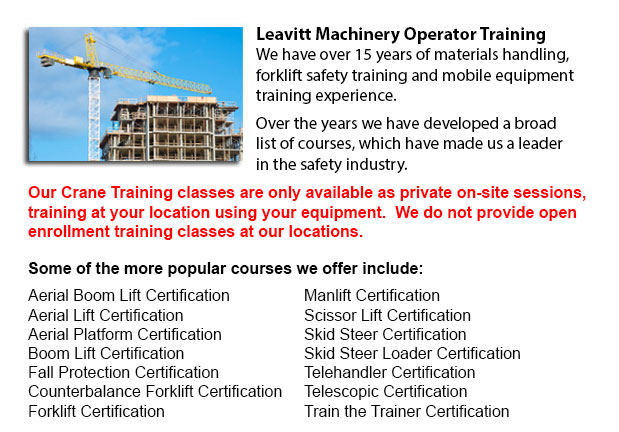
Overhead Crane Safety Training Prince Albert - The overhead crane safety training program is intended to equip the operators with the right knowledge and skills in the areas of: crane safety precautions, accident avoidance, materials handling, and stock and equipment protection. Each of the trainees will get to learn on many kinds of overhead cranes, their capabilities and their uses in different environments. For operators who are licensed and trained, the shift in liability moves from the company to the operator. Therefore, the course emphasizes individual operator duties.
The operators in the overhead safety training program will receive instruction on the right methods for doing inspections: the pre-shift inspection and the more detailed in-depth inspection. These are vital daily routines which should be logged. Correctly recorded pre-shift inspections help to protect the business from liability in the event of an accident. Pre-shift checks likewise prevent damage, expensive repairs and accidents. Operators learn how to designate a particular individual to carry out checks, how to report problems, and how to maintain the log book.
Every inspection must be carried out and documented regularly. Things which must be checked for possible concerns, include: increase in the throat opening, hooks for cracks, degree of twist; hoist ropes for corrosion, worn wires, loss of diameter, bird caging and kinks, broken wires, chemical and heat damage; chains for nicks and gouges, corrosion and cracks, twists, distortion, excessive wear, stretching, pits, damage from extreme heat.
The operator will get to learn the right ways about right rigging measures. The process of rigging involves the understanding of the manufacturer's data plate, determining the material weight to be lifted, choosing the gear, and using safe practices to secure the load. The course cover in detail the following: safe working loads, and the capacities of chains, ropes, hooks, shackles and slings.
It is essential to understand who can operate the cranes at your facility, the job's physical requirements, and operator credentials required for specialized job and permits. Safety should be prioritized when using near pedestrian traffic.
The duties involved in the safe crane use consists of checking for hydraulic leaks, undertaking visual inspections, testing the controls, checking the safety guards, examining the hoist rope and hook, limit switches and braking mechanisms. Correct reporting procedures are important. These topics are all covered in depth in the course.
The course likewise includes the right moving and lifting procedures with hoists and cranes. Operators would also learn correct hand signals. Training includes how to raise the load, attach the load, abort a lift, set the load and unhook the slings.
Moving the load includes a number of steps: starting and stopping procedures, controlling and guiding the load, working with signals and observing working conditions. Operators have to know how to proceed in case of a power failure. The program includes techniques for lowering the load and removing the slings, storage of equipment, parking the crane, and securing an indoor and outdoor crane.
-
Zoom Boom Training Prince Albert
Zoom Boom Training Prince Albert - Zoom Boom Training focuses on correctly training potential operators on variable reach forklifts. The training objectives include gaining the understanding of the machine's physics and to be able to define the job o... More -
Bucket Truck Training Prince Albert
Bucket Truck Training Prince Albert - The Vehicle-Mounted Aerial Work Platform or also called bucket truck training program is intended to reduce the chance of incident and personal injury when working with or in close proximity to bucket trucks by e... More -
Aerial Lift Training Prince Albert
Aerial Lift Training Prince Albert - An aerial work platform is a mechanized access platform. This device provides access to otherwise not accessible places for people or equipment. Likewise called an aerial device or elevating work platform, the mac... More -
Overhead Crane Ticket Prince Albert
Overhead Crane Ticket Prince Albert - The overhead crane is a common heavy machinery utilized in industrial settings. This particular machine is known as a bridge crane and comprises parallel runways spanned by a traveling bridge. The hoist is the co... More -
Scissor Lift Ticket Prince Albert
Scissor Lift Ticket Prince Albert - Scissor lifts have greatly benefited construction operations because the task that used to need a lot of effort and lots of people, can now be accomplished using the scissor lift and just one individual, the operat... More -
Manlift Training Prince Albert
Manlift Training Prince Albert - Different manlift training programs include the review and content of manlift devices. An essential part of the program is the practicum where students demonstrate their knowledge and practical ability to operate the... More -
Skid Steer Loader Training in Prince Albert
The engine powered skid-steer loader consists of a rigid and small frame, equipped along with lift arms which could attach to various industrial attachments and tools to be able to perform various labor saving tasks. Normally, skid-steer loaders are... More -
Crane Training School Prince Albert
Crane Training School Prince Albert - We provide industry relevant programs in our crane training school. The course will provide our trainees with learning outcomes matching the existing industry demands. Our small class sizes combine theory and han... More

Forklift Training Prince Albert
TOLL FREE: 1-888-254-6157
Prince Albert, Saskatchewan
forklifttrainingprincealbert.com
Email Us
About Us


